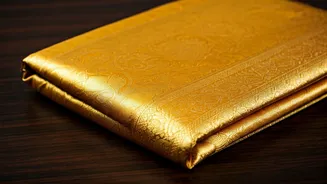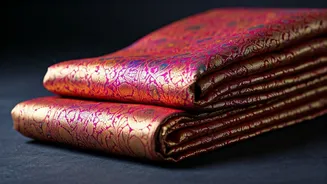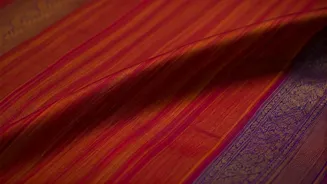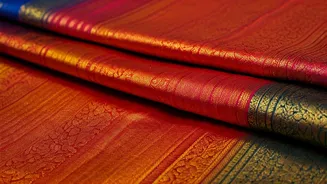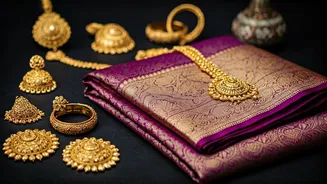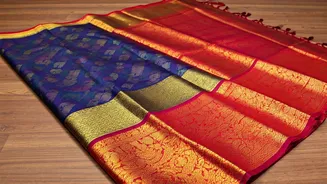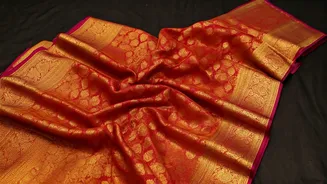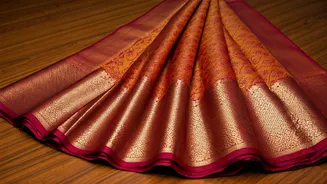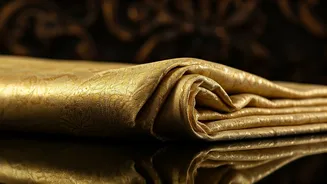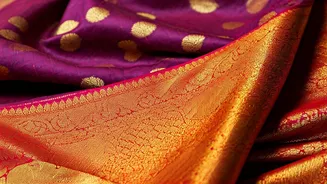Weaving Technique Insights
The first step to verifying the authenticity of a Banarasi saree lies in understanding its weaving. Authentic Banarasi sarees boast the use of detailed
techniques that are centuries old, showcasing exquisite craftsmanship. The most notable technique is the 'Kadwa' weave, where each motif is woven individually. This meticulous process ensures the design’s clarity and longevity. In contrast, cheaper imitations frequently use a quicker, less labor-intensive method known as 'Phekwa,' where the motifs appear less defined and the detailing is somewhat compromised. Examine the reverse side; in genuine sarees, floats are minimal and neatly finished. This also helps to prevent snags. The density and intricacy of the weave are significant indicators of the saree's authenticity and the amount of effort undertaken to create it.
Fabric Quality Analysis
The fabric of a Banarasi saree is a crucial indicator of its genuineness. Authentic Banarasi sarees use high-quality silk, frequently 'katan' or 'georgette.' These premium fabrics provide the signature drape and rich texture that Banarasi sarees are known for. Feel the fabric between your fingers, as the feel of genuine silk is distinctive. Furthermore, the saree’s weight is also a key factor; a genuine Banarasi saree is substantial, due to the high-quality silk and the intricate weaving. Compare this to cheaper imitations, which can utilize blended fabrics or artificial materials such as polyester, leading to a lighter weight and a less luxurious feel. Inspect the fabric closely for uneven textures or imperfections, which might indicate a less authentic piece. Authentic silk sarees will display a smooth, lustrous surface.
Zari Work Examination
The zari work is a hallmark of Banarasi sarees, providing their characteristic shimmer and opulence. True Banarasi sarees use genuine zari, consisting of silk threads coated with precious metals like gold or silver. This gives the zari its signature brilliance and durability. Check the zari’s appearance – genuine zari will have a consistent shine and a subtle, premium look. Fake zari, often made from metallic threads, will appear less lustrous and may tarnish easily. Observe the density and design of the zari work. Authentic Banarasi sarees show complex, detailed patterns, often integrating floral, geometric, and Mughal-inspired motifs. Inspect the zari closely for loose threads or areas where the metallic coating may be peeling off, which can signal that the zari is of inferior quality.
Motif and Design Scrutiny
The motifs and designs woven into a Banarasi saree tell a tale of heritage and expertise. Look carefully at the detailing of the designs; authentic Banarasi sarees feature intricate motifs like floral patterns (the 'buta'), paisley shapes (the 'kairi'), and figures inspired by Mughal art. These motifs are meticulously woven with great precision, offering clean lines and a raised appearance. Examine the design’s symmetry and balance; genuine Banarasi sarees generally display well-balanced compositions. Check that the design motifs are evenly distributed across the saree. Compare this to imitations, which might use simpler, mass-produced designs with less attention to detail, or that might lack the intricacy and refinement found in genuine pieces. Evaluate the colors used in the motifs. Authentic Banarasi sarees use rich, vibrant hues that retain their vibrancy over time, while lower-quality sarees may have colors that fade or bleed.
Price and Vendor Assessment
Pricing and the reputation of the vendor are important in ensuring authenticity. Authentic Banarasi sarees demand a significant investment due to the skilled labor, premium materials, and intricate weaving processes involved. If a saree’s price appears too good to be true, it likely is. Conduct research on the vendor. Purchase from reputable stores or weavers with a proven track record for selling genuine Banarasi sarees. Review customer feedback, seek recommendations, and inspect their inventory. Authentic vendors will be transparent about the saree's origin, the materials used, and the techniques employed in the creation. Question the vendor about the saree’s details. A trustworthy seller will willingly provide information about the saree's origin, the materials, and the craftsmanship involved. If a seller is hesitant or lacks knowledge about these details, it could be a warning sign of an imitation.
Authenticity Verification Techniques
To confirm the authenticity, seek assistance from saree experts or experienced connoisseurs. They can accurately assess the saree’s quality and authenticity. Examine the saree under natural light to reveal its true colors, texture, and the quality of the zari work. Request a certificate of authenticity from the vendor. A reliable seller may offer a certificate that guarantees the saree's originality. Consider consulting with a saree expert or a trusted professional. They can conduct a comprehensive inspection, which includes examining the weaving, fabric, zari work, and overall design of the saree. If you’re not an expert, consult someone who is. Taking these steps provides you with the knowledge and confidence to invest in a genuine Banarasi saree, ensuring that you're acquiring a piece of timeless beauty and cultural heritage.
